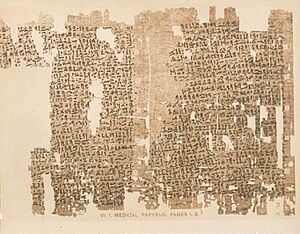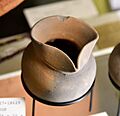El Lahun facts for kids
Quick facts for kids
El Lahun
اللاهون
ⲗⲉϩⲱⲛⲉ |
|
|---|---|
|
Village
|
|

Pyramid of Senusret II at Lahun
|
|
| Country | Egypt |
| City | Faiyum |
El Lahun (also called Illahun, Lahun, or Kahun) is an ancient village in Faiyum, Egypt. It was built by Senusret II, an Egyptian pharaoh. El Lahun is famous for the Pyramid of Senusret II, which is often called the Pyramid of Lahun. The ancient Egyptians called this place rꜣ-ḥn.t, which means "Mouth of the Canal." Later, during the Ptolemaic Kingdom, it was known as Ptolemais Hormos.
Contents
The Pyramid of Lahun
The Pyramid of Lahun is special because it was built mostly from mudbrick. To make it strong, the builders used a network of stone walls inside, filling the gaps with mudbricks. This helped keep the brick structure stable.
Finding the Entrance
Usually, pyramid entrances are on the east side. But the entrance to Senusret II's pyramid is on the south! The archaeologist Flinders Petrie spent a long time looking for it on the east. He only found it when workers clearing nearby tombs discovered a secret tunnel. This tunnel led to the king's burial chamber. It seems the original builders might have used their work as a cover to dig this tunnel and rob the pyramid. Once Petrie was inside, he could figure out where the real entrance was.
Pyramid Surroundings
The pyramid sits on a flat area that was carved out of a sloping hill. On the north side, there are eight stone blocks that look like small tombs called mastabas. These were probably for important people connected to the royal family. Each mastaba has a narrow shaft leading to a burial chamber below. Also on the north side is a smaller pyramid, likely for the queen.
The Ancient Workers' Village
One of the most exciting discoveries at El Lahun was the village where the pyramid builders lived. This village, known as Kahun, is about 800 meters from the pyramid. It's in the desert, not far from where farming happens.
Life in Kahun
When Petrie first found the village, many buildings still had their roofs! He even saw that the ancient Egyptians knew how to build true arches. Sadly, during the excavation, the buildings were taken apart to uncover more. So, there's not much left to see there today. The village was mainly for people who built the pyramid and then took care of the king's tomb and temple after he died. This included administrators and temple staff.
Petrie excavated the village in 1888–90 and again in 1914. He found many everyday items and tools in the houses. It seemed like the workers left suddenly, leaving everything behind. Among the interesting finds were wooden boxes buried under the floors of many houses. These boxes sometimes held the skeletons of infants, often two or three in one box, who were only a few months old when they died. Petrie reburied these remains in the desert.
The Kahun Papyri
Archaeologists also found the Kahun papyri in the village. These are about 1000 pieces of ancient paper that talk about legal issues and medical treatments. In 2009, Egyptian archaeologists found more mummies in brightly painted wooden coffins near the pyramid.
The site was used until the end of the Thirteenth Dynasty. It was used again later during the New Kingdom, when people worked on large land projects in the area.
How the Town Was Designed
The town of Kahun was built with a very organized plan. It had mudbrick walls on three sides. There might have been a fourth wall, but it could have been washed away by floods. The town was shaped like a rectangle.
Dividing the Town
Inside, a large mudbrick wall divided the town into two main parts. About one-third of the town had rows of small, single-room houses. These houses were built back-to-back and side-by-side. The other, larger part of the town was on higher ground, where it could catch more breeze. This area had fewer, but much larger, multi-room villas. The big houses were up to 2,520 square meters, while the small ones were about 120 square meters. It was like a mining village where workers lived in small homes in the valley, and the bosses lived in bigger houses up the hill.
Important Buildings
One important building in the town was called the "acropolis." It was a grand building, shown by the bases of columns found there. Petrie thought it might have been where the king stayed when he visited the pyramid construction. This building seemed to have been abandoned before the town was completely left.
Some records show that many people from other lands, especially Semitic people, were in Egypt during the Twelfth Dynasty. It's interesting that some villas were built with layers of mudbrick separated by reed mats. This building method was also used in Mesopotamia. Also, burying people under house floors was a custom seen in the ancient city of Ur. This makes some experts wonder if the workers, who were kept separate by strong walls, might have been Semitic (Asiatic) people not fully trusted by their overseers.
Recent Discoveries
On April 26, 2009, the Supreme Council of Antiquities announced an exciting find near the Lahun pyramid. They uncovered many mummies in colorful wooden coffins! The coffins were painted green, red, and white, with pictures of the people inside. Dozens of mummies were found, and thirty of them were very well preserved. They even had prayers written on them to help the deceased in the afterlife.
New Insights into Ancient Egypt
Experts believe these discoveries could help us understand more about Egyptian burial practices from the Middle Kingdom all the way to the Roman era. The tombs were carved into the rock itself and had different designs. Some were built on top of even older burial sites.
Archaeologist Abdel Rahman El-Aydi, who led the excavations, said that people used to think this site was only started by Senusret II. But with these new finds, they might change that idea. He hinted at finding something even older than the 12th Dynasty, promising a big announcement soon.
More Tombs Found
On May 23, 2010, Egypt's Supreme Council of Antiquities announced another big discovery: 57 ancient Egyptian tombs near Lahun! Most of these graves had a decorated wooden coffin with a mummy inside. Some of the tombs were incredibly old, dating back to the First and Second dynasties, around 2750 BC. Many sites were decorated with hieroglyphics that ancient Egyptians believed would help the dead travel through the afterlife.
Twelve of the tombs belonged to the Eighteenth Dynasty (around 1550–1292 BC). Egyptologist Zahi Hawass said these mummies were wrapped in linen decorated with religious texts from the Book of the Dead and scenes of ancient Egyptian gods. This discovery could help experts learn more about ancient Egyptian religions. El-Aydi mentioned that one of the oldest tombs was almost untouched, with all its burial items and a wooden coffin holding a linen-wrapped mummy.
In 31 tombs from the Middle Kingdom (around 2030–1840 BC), archaeologists found pictures of different ancient Egyptian gods like Horus, Amun, Hathor, and Khnum.
Images for kids
See also
- List of ancient Egyptian sites, including sites of temples






